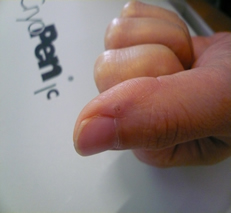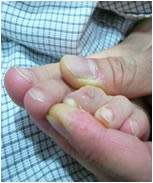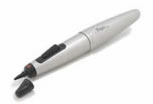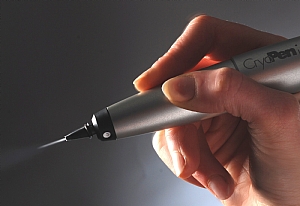CryoPen 冷凍筆
Revolutionise cryosurgery, no pain, no scar, no wound.
Accuracy down to 1mm, recurrence less than 15%.
And the whole procedure takes no more than 1 minute.
How CryoPen works
 Practical Cryosurgery in medicine
Practical Cryosurgery in medicine
Cryosurgery is broadly defined as the controlled destruction of unwanted tissue by the precise application of extreme cold during clinical procedures. It is a well proved method in effect a destruction of living tissue, because normal and diseased cellular elements will not survive after being subjected to freezing to minus (-) 27°C. In other words, how to accurately and effectively bring down the temperature without collateral damage is the key of success for cryosurgery.
Why cryosurgery gives you no scar?
Unlike other methods of tissue ablation, such as chemical corrosion, cauterisation, surgical excision or even laser; cryosurgery will only destroy cellular component without altering the collagen scarfolding. Therefore, when the tissue heals by regenerating its cell, the new cells fill up the spaces among the fibrous tissue, hence macroscopically, there will be no scar.
It is an analogue of dropping a bomb into a city as in tradition methods of tissue ablation with chemical corrosion, cauterisation, surgical excision or even laser. The whole city will be destroyed even when one take a bird eye view from an aeroplane. Cryosurgery is like taking a city into a drastically freezing weather (as in the movie "days after tomorrow"), even when every citizen dies, when new immigrants come in, you probably cannot realise any change when viewing from a plane.
Furthermore, since cryosurgery will not disrupt the cornified layer (the outermost layer of skin), there will be no wound for you to care. You can still go on your usual life style, including shower.
 Why cryosurgery is not painful?
Why cryosurgery is not painful?
Since most of the skin lesions do not contain free nerve endings, any tissue destruction limited inside the skin lesion will not cause any pain (don't you realise your skin mole is less sensitive to touch when compared to its surrounding skin?)
In addition, cooling can numb the nerve, therefore the whole process is not painful. In any event of discomfort, it is well tolerable, even for children.
 Why cryosurgery is not popular?
Why cryosurgery is not popular?
In the past, cryosurgical instructment can be categorised into 3, liquid nitrogen,compressed air and can type cryogen. However, each of them has its limitation, making them not popular. Until 2004, there is no solution for this.
以往冷凍治療儀器可分為3類,包括液態氮 liquid nitrogen、壓縮氣體CO2,以及噴罐式冷凍劑 histofreezer wartner 疣立消。但各有自己的問題,直至2001年,也未有解決方法。
Determinating factors for success in cryosurgery
In short, the key is how to effectively bring the targetted tissue into the ultra-low temperature rapidly. Keywords are rapidly and ultra-cold.
Even primary school student knows Oskimos live in ilgoo. But why? It is because ice has a very low heat conductivity, lower than water or even air. Therefore regardless of how chilling outside is, inside the igloo, it is still warm and comfortable. Getting back to the practice of cryosurgery, it will be of vital importance to bring the temperature low rapidly. The deeper part of the tissue must be brought down well below -27°C before the superficial part start to freeze. Or else, the deeper part of the lesion will never achieve desirable temperature.
Slowing freezing not only hamper the depth of cryosurgery but also protect the cells from dying. If temperature is brought down slowly, water inside the cells will flow out by a process called osmosis. That will offer a protection, leading to cell preservation instead of necrosis. On the other hand, if freezing process is rapid, cells will be dehydrated because liquid water is getting less and less with ice formation. Toxic elements concentration build up and cause death. Intracellular ice crystals formation will take up more volume and burst the cell membrane. It is of the same phenomenon when you place a can of coke inside the freezer.
With rapid freezing, a second phase of cell destruction will come into play by vascular stasis due to clot formation (blood not just get frozen with colding, its cells burst and start a process called thrombosis, or in a common term, blood clot formatin) In late phase, an immunologic response due to freezing is also responsible for continuous destruction of the once frozen tissue.
Are all cryosurgical instrument being the same?
It is correct that unless being specially processed, virtually all biological tissues subjected to a temperature of minus (-)27°C undergo cryonecrosis. But it is not all cryosurgical instrument being equal in their ability bringing down the tissue rapidly to ultra-low temperature in an accurate manner.
In more traditional cryosurgical treatments, the doctor dip a cotton swab into a refrigerant solution (also known as cryogen) or spray the cryogen into an applicator. Since the cryogen stay in the absorbant (sponge or cotton bud), this kind of method is called indirect cryosurgery. Understandably the cooling power is just sufficient to form ice at the tip of the applicator. With the formation of ice, given ice is a poor heat conductor, indirect cryosurgical tool will not be able to push the ice-ball to the deeper part of the lesion.
It is like how we cook. There will be no one heat the frying pan, turn off the gas stoven before putting the chicken wings onto it. Even though you might have skin done, it will not be surprising to see the meat is raw. The surest way is to put the chicken wing into fire, like what we do in BBQ.
Having BBQ in cryosurgery is called direct cryosurgery. The most commonly seen direct cryosurgical method is spraying liquid nitrogen directly onto the skin lesion. However, the sprayer creates divergent jets, covering the skin lesion but also the surrounding tissue. This collateral damage not only cause pain, but also limits its application to large lesion (size must be bigger than 5mm) in area covered by cloth (unless you are comfortable to reveal the bulla to others).
Since tissue is a poor thermal conductor, the forming layers of ice will hamper the ability of extreme temperatures to penetrate to the distal end of the lesion unless there is enough available freezing power. New developments in cryosurgery with the CryoPen bring control over temperatures and penetration depth. In all cases a second freeze in the same treatment session will improve results dramatically. There is little to no discomfort in most cases, negating the requirement of anaesthesia.
How do CryoPen rectify the situation?
CryoPen is a direct cryosurgical tool, utilising pressurised liquid nitrous dioxide (N2O, also known as laugh gas). The pressure is up to 725 pound per square inch (psi), high enough to penetrate the deepest part of skin. The Cryopen directly deliver the cryogen in convergent and focused jets (thanks to its applicator channel is manufactured with excimer laser, with diameter of being 30 micron only)。It can bring the spot to a temperature as low as -89°C.
The freezing process is very steady, it takes every 5 second to go 1mm deeper. When freezing is limited inside the skin lesion, given it does not have nerve ending in it, no pain will be felt. When the ice-ball extend below the deepest part of the skin lesion and start to involve normal tissue, the patient can tell he can feel from cold to "pain" (though mild). This is called biofeedback. The doctor can add 5 to 10 second more thus creating a 1 to 2mm margin, making sure all the altered cells are destroyed. This revolutionary change make Cryopen one of its kind offering the doctor this margin of confidence, not even when you are operating laser machine!
In addition, Cryopen bring down temperature quickly, nerves will be frozen before it has a chance to send out "pain" signal. As such, any discomfort is tolerable, even in children. No wonder it is the most recommended treatment for skin lesion by paediatrician.
The applicator is made of medical grade polymer called PEEK. It will not stick to the frozen tissue as in the traditional applicator, and, it is autoclavable. Safety is of primal concern in every doctor's mind.
